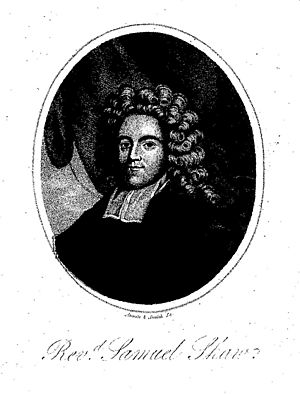Samuel Shaw (minister) facts for kids
Samuel Shaw (born 1635, died 1696) was an English minister who chose not to follow the official Church of England. People like him were called "nonconformists."
Contents
Early Life and Education
Samuel Shaw was born in 1635 in Repton, Derbyshire. His father, Thomas Shaw, was a blacksmith. Samuel went to Repton Grammar School and later studied at St John's College, Cambridge, where he earned his first degree.
Becoming a Minister
In 1656, Samuel Shaw became the headmaster of the grammar school in Tamworth, Warwickshire. A year later, he started working as a curate (a type of assistant minister) in Moseley, Worcestershire.
Since there wasn't a local church group (called a "classis") in Worcestershire to officially make him a minister, he traveled to Wirksworth, Derbyshire. There, a Presbyterian classis ordained him on January 12, 1658.
Soon after, Oliver Cromwell, who was then the leader of England, appointed Shaw to be the rector (head minister) of Long Whatton, Leicestershire. Shaw officially took on this role in June 1658.
Challenges and Changes
After the monarchy was restored in England, Samuel Shaw faced difficulties. In 1661, he was removed from his position at Long Whatton. The next year, a new law called the Uniformity Act 1662 was passed. This law required all ministers to follow the Church of England's rules strictly, including being re-ordained by a bishop. Shaw refused to be re-ordained, which meant he could no longer hold an official church position.
He moved to Coates, Leicestershire. In 1665, during a time when the bubonic plague was spreading, Shaw sadly lost two of his children to the illness.
Life as a Schoolmaster
At the end of 1666, Shaw moved to Ashby-de-la-Zouch, Leicestershire. In 1668, he became the headmaster of the grammar school there. He was able to get a special license from the Archbishop, which allowed him to teach even though he was a nonconformist. The Bishop of Lincoln, William Fuller, also supported him.
Shaw's school became very successful. Many students boarded at his house, and some of them later became important ministers in the Church of England. He even wrote plays for his students to perform during Christmas! He also helped rebuild the schoolhouse and added a special seating area in the local church for his students.
When the Toleration Act 1688 was passed, which allowed nonconformists more freedom, Shaw used his schoolhouse for nonconformist church services. However, he made sure to preach only between the regular church service times, and he and his students still attended the main parish church.
Samuel Shaw was known for his long, heartfelt prayers, which could sometimes last for hours. He passed away on January 22, 1696.
Writings
Samuel Shaw wrote several books and sermons during his lifetime. His first published work was a speech he gave in 1657 for the funeral of Thomas Blake, who was a minister in Tamworth.
Some of his other notable works include:
- ‘The Voice of One crying in the Wilderness,’ published in 1666. This book included a piece called ‘A Welcome to the Plague.’
- ‘Immanuel,’ published in 1667.
- ‘The Great Commandment,’ published in 1679.
- ‘Words made Visible, or Grammar and Rhetoric,’ a comedy play from 1679.
- ‘The True Christian's Test,’ published in 1682, which contained 149 meditations.
- ‘Grammatica Anglo-Romana,’ published in 1687.
- ‘Ποικιλοφρόνησις: or, The Different Humours of Men represented at an Interlude in a Country School,’ published in 1692.
- ‘An Epitome of the Latin Grammar,’ published in 1693.
Family Life
Samuel Shaw married the daughter of Ferdinando Pool, who was also a minister. His son, Ferdinando Shaw, followed in his footsteps. Ferdinando became a minister in Derby in 1699 and published several sermons and a book called ‘A Summary of the Bible.’ He died in 1744.
Images for kids



